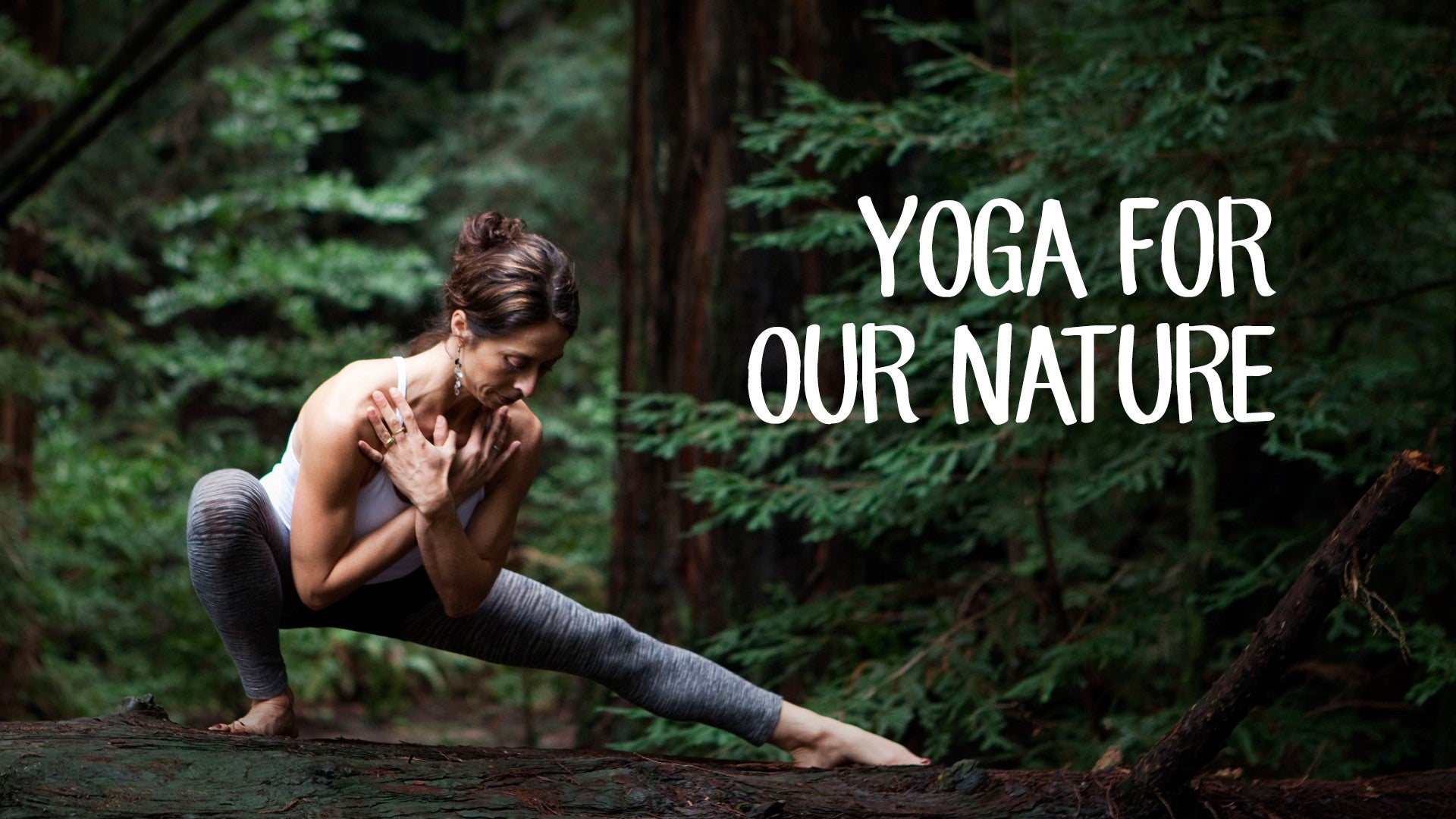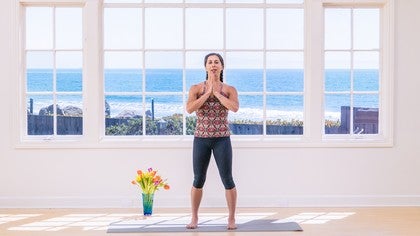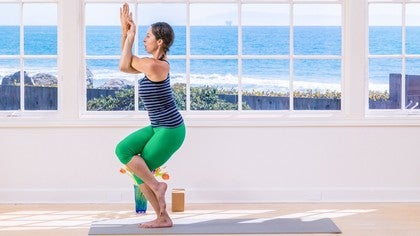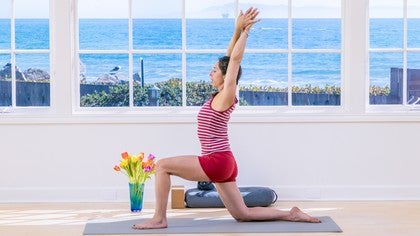Description
About This Video
Transcript
Read Full Transcript
Namaste and welcome to seasonal vinyasa yoga. I'd like to introduce you to a practice that came to me a while back after being asked the question multiple times, what style of yoga do you teach? And one day it dawned on me that my practice changed often with the seasons. I was living in Seattle for a long time and how I practiced yoga and what I ate and different themes were very different in the winter from in the spring. So I was really aware of how the seasonal changes were impacting my yoga.
So this is sort of a collection of hatha yoga, ayurveda and nutritional practices that I have found really wonderful to help you expand your definition of yoga throughout the seasons. So if we start with spring, sort of the time of renewal. Spring often times has a very poetic feel to it. It's so vibrant and colorful as the earth begins go wake up after the winter slumber, and the North American country we say spring might be from our March to our May window, and during that time when there's renewal, often times we hope that within our self that we have that spring energy, that vibrant energy, the spring fever as they say. Which usually means that we rested well during the winter months.
So when we get to the spring time, often times it's an important time of the year to start to lighten up and to clear spaces where we're accumulated mass during the winter time and that can literally be in your refrigerator, your car, your desk, your desktop, as well as in your body where we accumulated potentially extra weight from the winter. Which is natural and often a really good thing, but how do we start to eliminate so that we can illuminate and highlight the things that are gonna be valuable in the seasons to come? So in the diet it's a wonderful time to drop into elimination diets, do kitchery for several days, and to get rid of a lot of the heavy fats that we might have been enjoying during the winter time to use the resources that we've stored over the winter, and then when it comes time to the asana practice, it's a wonderful time to commit to a daily practice that allows you to sweat everyday until you start to feel that your lighter both in your mind and in your body. That your energy levels are very stable throughout the day and that you have the strength to follow through on your new intentions. So we often find in the spring peoples willpower's quite strong to drop into their intentions and to continue to water the seeds that you intend to plant to watch mature and ripen into the summer time.
So it's a time for really steady regular exercise, dynamic movement. To really feel like your body is cleansing through sweating and through elimination that comes through eating lots of food that has a lot of fiber in it, and you're well hydrated. That the body then comes back to a place ready to go and have all the adventures that you'd like to have in the summer time. As we move into the summer window. In the North America it's our June to August window.
It's a pitta time of year. Typically we could describe that as very hot very intense time of the year. It also can hopefully be a times for some vacation and a time to explore recharging yourself outside. Recharge your solar batteries really outside. So if we take vacations and we spend time doing things that are nourishing you soul.
Often times the pitta season, the heat won't be so troublesome. You'll usually be more patient, less irritated if you do take time off versus in the summer if you work all the time or sign up for a whole bunch of competitions. That can start to build extra heat and aggression in ones body and mind and can really kinda burn you up on the inside. So in the summer we're trying to remember to stay cool and not do too many things that bring fire to your practice. So in the diet department, it's the time when nature is ripe and there's so much fruit to eat and color fruits are a great thing to eat a lot of during that time of the year.
They're quick carbohydrates that you would use to graze upon to help you get through all the activities that you do in the summer day, and so since we have so much more light, it's often a time of the year that people eat more than three times a day. That there's more snacking to get through your activity. So enjoying all the greens that are available, the colorful fruits. That's the time of the year where we wanna really embrace the bounty of what nature is offering, and when it comes to our asana practice in the summer to start to think about if you have vigorous asana practice to try to do that in the morning time of the day. The cool part of the day so that you're again, as I mentioned, not adding extra heat, fire to your system.
So vigorous work in the morning. If you like to hike and you live someplace warm to do that before it gets hot outside, or later in the evening. So more of the copa times of day. So those are a couple basic things to do with the summer, and the summer theme we'll do together in the summer practice is to allow yourself to awaken more of your intuition in the practice. Which is not always what the pittas want to do, but as we explore closing our eyes, as an example, more and more in your yoga practice.
Often times you'll be moving in different patterns than you did when your eyes were open and you've gone through that same pose 1,000 times. So it's not so fresh anymore. So when we close the eyes it often brings us into a place we're a little bit more intuitive and you're maybe feeling the mat under your hand more or you're listening and hearing your breathe more than when your eyes are open. Which is just, I found, an interesting practice to do in the summer, and then rest your eyes. Which can also get very dry during the summer when we're looking out into bright sunlight for multiple hours.
So those are a few ideas of some summer practices, and then when it starts to feel like fall where you are, and in North America it'd be more the September to November window. It's a time where there's a lot of change, a lot of movement, a lot of dryness, and it's a vata time of the year, and so we wanna do things that sooth vata, and as we think about themes that might be occurring in the fall. For some people there's in transition a lot of worry and fear, and for some people perhaps in the transition season where the leaves drop and there's more space. When you look up at the sky, that you might be more inspired. There might be more creativity flowing through you in the fall time.
So there's not one way that I would expect someone to be, it really depends on your nature, but in general as we go toward that dryer season and see vata as a dry condition and often a cold dosha or condition. That we wanna do things in your life that have more warmth. That have oil, so I think heat, and oil, and routine are three pieces to work on in the fall. So if possible, one would try to commit to having a regular bedtime in the fall, and a time to come inside earlier as we start to notice there's less light. Sort of a natural time to harvest and wrap up projects.
That if we come inside more we find maybe that we cook food, we're close to the stove, that we've having warm foods instead of cold foods. Which were okay in the summer, and whatever we're eating that we're being generous with oil to help combat the dry nature of the season, and if we're committing to our regular bedtime. Which may be 10 o'clock or earlier, that we often will find that we will get up more easily in the morning and then begin our routine practices of hydrating, doing some yoga, or pranayama, some sitting before eating some more foods and getting on with the day. So vatas really thrive with routine. It's not necessarily what they enjoy, and I usually encourage people to start with a simple routine that you can be successful in before getting too elaborate with your commitments and routines.
So bedtime and hydrating in the morning are a couple simple ways to start bringing ayurveda into your practice and just to witness the benefit of doing less in your day. Saying no a little bit more, having some boundaries as you start to notice that you might have less energy as there's less light from the outside, and then when it comes to your asana practice, that we would spend some times also going a little bit slower. That maybe there isn't quite as much dynamic heating movement that you have enough rhythm to the practice to keep prana regular and that we embrace props, we embrace supports. Including the ground, or blocks under your hands, or blanket over you in shavasana. As a few ways to help you feel again, more connected to earth, to stable matter at a time of the year where there's so much change and fluctuation.
So I think of yin yoga, restorative yoga are all wonderful ways to balance the tendency of vata to be more anxious, or worried, or rushed, and through any transition time of the day really we try to embrace the breathe and embrace hydration as ways to sooth vata, and then we slide into our winter season, and in our culture, Northern America. The December through February window is that copa season where things are quite dormant and if you're outside you'll notice that there isn't much growth happening. The earth is frozen in some places or potentially very wet or very dry is you're in Colorado for example. Very wet if you're in Seattle. So winter could have some different characteristics to it, but in general we think of it as a copa season that's very stable and slow, and if we could be like an animal.
A wild animal like a bear and have a cave to go disappear and hibernate to it'd be a wonderful thing to do in the winter time is to take a break to retreat, to be quiet, to replenish yourself when there isn't a lot of natural light from the sun outside. Often times we notice we might not have the same energy in the winter that we do in the spring time or the summer time. So how can we organize our life so that it's less busy? So that it's more calm, more quiet, and since for a lot of us that's not possible to go disappear in a cave for a few months. How to create some of that feeling of retreat within your week.
So I encourage people to try to think about coming home and just lighting candles in the room that you're occupying so that you're tending to less space. That perhaps that you're spending some time of the day silent. Which means that you're not reading, you're not on the email, that you're just actually being reflective. Maybe looking out the window, walking, not having conversations, and being quiet with yourself as a wonderful way to align with the energy of that season, and I also think diets really important at that time of the year to have enough of fats and oils and well balanced meals to stay warm and to keep your energy level balanced because we're not retreating, for a lot of us, to a cave. We still have to work our regular schedules and do our regular commitments.
Even though we have may a little less energy. So food is a great way to help fuel your day. Assuming that we're eating the right foods for us. A couple things that can be really challenging in that winter section of the year is that it's the time of the year where there's a lot of celebration, a lot of opportunity to over eat and to start to put on weight by all the holiday celebrations. All the sugar and snacks and cookies that everybody creates in that time of the year, and all the alcohol that can be consumed in all the celebratory events that often tend to promote more mood swings for people.
That really alter your energy levels, and then often it lead to more depression. Especially if we're also putting weight on during that time of the year. That nature isn't really making it as easy for a lot of us to be outside exercising like we did in the summer. So just looking at how changing your diet to be very clean, very healthy. How that effects your mind state and your energy level throughout the day.
So as best as we can trying to protect that. When we think of the asanas and what we can do. I think it's important to keep circulation as the forefront of what's important in the winter so that we don't freeze, we don't get stagnant in the mind and in the body. So I'm always aware of having eyes open in the winter time when I practice to not miss any light that's available in these short day, and to have the movement be dynamic so it's almost aerobic in a way that's keeping enough circulation to the point right where you're about to sweat and we don't have to go through a big sweat everyday, but just having a few times of the day where you're very conscious of moving your body in a dynamic way to create heat so that our energy level stays balanced throughout the day, and then whatever you're taking in is actually being digested through the senses. It's also a time of the year that I think it's nice to prioritize, in some way meditation to again, reflect the stillness of the year and if you find that when you're doing meditation that it tends to make you feel heavier or go towards depression, that one suggestion is to simply stand when you do your meditation.
There's a practice on Yoga Anytime of a short standing meditation that you can watch. Another idea is if you sit to meditate to have your eyes open and to stare at a candle that's an arms length away and about the height of your eyes so that your head is not tilting forward, and we do that classic candle gazing as a way to bring more fire and light into your heart, into your body at a time of the year that might feel dark and potentially for some people too dark. So that's one wonderful practice that I like to use really in the new moon time and in the winter times when there's dark phases of the year, and those are a couple of the pieces that I would start somebody with for the seasonal practices and hopefully you start to look forward to what's special about the spring and the elimination phase and what's encouraged in the summer to eat lots of colorful foods and be outside a lot and in the fall to start to slow down and be at home and cooking your soups, and then in the winter time to be in that quiet hibernation phase that there's something special about each season and its personality, and I hope you enjoy discovering some of that and adding many more practices to this list on your own. So thank you so much, manaste.
Yoga for Our Nature
Comments
You need to be a subscriber to post a comment.
Please Log In or Create an Account to start your free trial.








